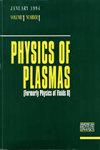Flowing plasma rearrangement in the presence of static perturbing fields
IF 2.2
3区 物理与天体物理
Q3 PHYSICS, FLUIDS & PLASMAS
引用次数: 0
Abstract
Charged particles interacting with electromagnetic waves have a portion of their energy tied up in wave-driven oscillations. When these waves are localized to the exhaust of linear magnetic confinement systems, this ponderomotive effect can be utilized to enhance particle confinement. The same effect can be derived for particles moving via an E×B drift into a region of a static perturbation to the electromagnetic fields which has a large wave vector component in the direction of the motion. In this work, we use a simplified slab model to self-consistently solve for the electromagnetic fields within the fluid flowing plasma of a static flute-like (k∥=0) perturbation and evaluate the resulting ponderomotive potential. We find that two types of perturbations can exist within the flowing plasma, which are an O wave and an X wave in the frame moving with the fluid. In the case of tenuous plasma, these perturbations are magnetostatic or electrostatic multipole-analog perpendicular to the guiding magnetic field in the lab frame, respectfully. For denser plasmas, the O wave-like perturbation is screened at the electron skin depth scale, and the X wave-like perturbation is a combination of a similar perpendicular electric perturbation and parallel magnetic perturbation. The ponderomotive potential generated in the X wave-like case is gyrofrequency-dependent and can be used as either potential barriers or potential wells, depending on the direction of the flow velocity.存在静态扰动场的流动等离子体重排
与电磁波相互作用的带电粒子,其部分能量会被波驱动的振荡所束缚。当这些波被定位到线性磁约束系统的排气装置上时,就可以利用这种思索动力效应来增强粒子约束。对于通过 E×B 漂移进入电磁场静态扰动区域的粒子来说,也可以得出同样的效应,因为电磁场在运动方向上有很大的波矢量分量。在这项工作中,我们使用一个简化的板坯模型来自洽地求解静态笛状(k∥=0)扰动的流体流动等离子体内的电磁场,并评估由此产生的思索动势。我们发现流动等离子体内可能存在两种扰动,在随流体运动的框架内分别是 O 波和 X 波。对于致密等离子体,这些扰动分别是垂直于实验室框架中引导磁场的磁静电或静电多极模拟。对于密度较大的等离子体,O 波状扰动在电子表皮深度尺度上被屏蔽,而 X 波状扰动是类似的垂直电扰动和平行磁扰动的组合。在 X 波样情况下产生的深思动势与陀螺频率有关,可根据流速方向用作势垒或势阱。
本文章由计算机程序翻译,如有差异,请以英文原文为准。
求助全文
约1分钟内获得全文
求助全文
来源期刊

Physics of Plasmas
物理-物理:流体与等离子体
CiteScore
4.10
自引率
22.70%
发文量
653
审稿时长
2.5 months
期刊介绍:
Physics of Plasmas (PoP), published by AIP Publishing in cooperation with the APS Division of Plasma Physics, is committed to the publication of original research in all areas of experimental and theoretical plasma physics. PoP publishes comprehensive and in-depth review manuscripts covering important areas of study and Special Topics highlighting new and cutting-edge developments in plasma physics. Every year a special issue publishes the invited and review papers from the most recent meeting of the APS Division of Plasma Physics. PoP covers a broad range of important research in this dynamic field, including:
-Basic plasma phenomena, waves, instabilities
-Nonlinear phenomena, turbulence, transport
-Magnetically confined plasmas, heating, confinement
-Inertially confined plasmas, high-energy density plasma science, warm dense matter
-Ionospheric, solar-system, and astrophysical plasmas
-Lasers, particle beams, accelerators, radiation generation
-Radiation emission, absorption, and transport
-Low-temperature plasmas, plasma applications, plasma sources, sheaths
-Dusty plasmas
 求助内容:
求助内容: 应助结果提醒方式:
应助结果提醒方式:


